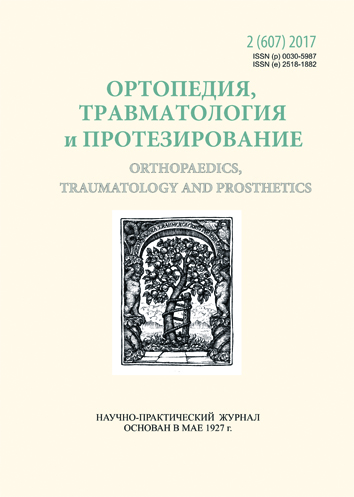Radiometric parameters of the sacrum and pelvis, affecting the spine and pelvic balance in the frontal plane, in healthy volunteers
DOI:
https://doi.org/10.15674/0030-59872017252-61Keywords:
sacroiliac joints, sacral foundation, pelvic tilt, sacral slopeAbstract
Objective: to study in healthy volunteers radiometric parameters of sacrum and pelvis, affecting the spinal-pelvic balance in the frontal plane and their relationship to each other.
Methods: we examined 36 healthy student volunteers (25 males and 11 females aged 17 to 23 years). The average height was 173 cm (from 168 to 183), average body mass index — 22.23 (from 17.90 to 29.38). Standing X-ray examination performed in all the volunteers. X-rays were measured: 1) the angle of the cranial sacral bone plate by the method of R. E. Irvin in frontal plane; 2) the angle of the pelvic tilt; 3) the angle of rotation around the sacrum axis by method of A. Orel; 4) width of sacroiliac joint in the ventral, dorsal and medial portions. Results were assessed using statistical methods.
Results: the majority of volunteers (81 %) had asymmetric joint space width of sacroiliac joint, which accompanied pelvic and sacral tilt and sacral bone rotation. The sacral slope measured in 95 % of patients, pelvis — 83 %, sacral rotation in 92 %. The width of the joint space of volunteers was (3.3 ± 0.9) mm. Using cluster analysis all volunteers were divided into four clusters (groups), characterized by certain parameters. In the first group examined joint space width was symmetrical in all portions, pelvic tilt and sacral slope were the same, the rotation of sacrum decreased. Joint asymmetry found in two groups of volunteers in the third and fourth groups (39 %, 14 persons) and three parts — other (42 %, 15 people). Found that 20 volunteers (56 %) had joint space asymmetry, pelvic tilt and sacral slope, sacral rotatio 3°, the maximum deviation (more than 3°) these indicators are recorded in 7 volunteers (19 %).References
- Kerr HE. Observations on anatomical short leg in a series of patients presenting themselves for treatment of low-back pain. J Am Osteopathic Association. 1913;42:437–40.
- Kappler RE. Postural balance and motion patterns. Postural balance and imbalance. B. Peterson (ed). American Academy of Osteopathy, Indianapolis, IN, 1983. рр. 6–12.
- Denslow JS. Mechanical stresses in the human lumbar spine and pelvis. Postural balance and imbalance. B. Peterson (ed). American Academy of Osteopathy, Indianapolis, IN, 1983. рр. l44–51.
- Kuchera ML. Prolotherapy in the lumbar spine and pelvis. Spine: State of the Art Reviews. 1995;9(2):463–90.
- Greenman PE. Lift therapy: use and abuse. J Am Osteopath Assoc. 1979;79(4):238–50.
- Korzh NA, Staude VA, Kondratyev AV, Karpinsky MYu. Stress-strain state of the system «lumbar spine – sacrum – pelvis» in the conditions of front pelvis. Orthopaedics, Traumatology and Prosthetics. 2016;(1):54–62. doi: 10.15674/0030-59872016154-61. (in Russian)
- Korzh NA, Staude VA, Kondratyev AV, Karpinsky MYu. Stress-strain state of the kinematic chain «lumbar spine – sacrum – pelvis» in cases of asymmetry of articular gaps of the sacroiliac joint. Orthopaedics, Traumatology and Prosthetics. 2015;(3):5–14. doi: 10.15674/0030-5987201535-13. (in Russian)
- Irvin RE. Reduction of lumbar scoliosis by the use of heel lift to level the sacral base. J Am Osteopath Assoc. 1991;91(1):37–44.
- Orel А.М. Spine X-ray examination for manual therapeutist. Vidar, 2007. 311 p. (in Russian)
- Dott GA. Hart CL, McKay C. Predictability of sacral base unlevelness based on iliac crest measurements. J Am Osteopath Assoc. 1994;94(5):383–90.
- Dijkstra PF. Basic problems in the visualization of the sacroiliac joint. Movement, Stability & Lumbopelvic Pain. Churchill Livingstone, Edinburg, 2007. рр.299–310.
- Demir M, Mavi A, Gümüsburun E, Bayram M, Gürsoy S, Nishio H. Anatomical variations with joint space measurements on CT. Kobe J Med Sci. 2007;53(5):209–17.
- Ehara S, El-Khoury G, Bergman R. The accessory sacroiliac joint a common anatomic variant. Am J Roentgenol. 1988;150(4):857–9. doi: 10.2214/ajr.150.4.857.
- Ravin T. Visualization of peivic biomechanical dysfunction. Movement, Stability & Lumbopelvic Pain. Eds. Vleeming A, Mooney V, Stoeckart R. Churchill Livingstone, Edinburg, 2007. рр. 327–39.
Downloads
How to Cite
Issue
Section
License
Copyright (c) 2017 Volodymyr Staude, Yevgenya Radzishevska, Ruslan Zlatnyk

This work is licensed under a Creative Commons Attribution 4.0 International License.
The authors retain the right of authorship of their manuscript and pass the journal the right of the first publication of this article, which automatically become available from the date of publication under the terms of Creative Commons Attribution License, which allows others to freely distribute the published manuscript with mandatory linking to authors of the original research and the first publication of this one in this journal.
Authors have the right to enter into a separate supplemental agreement on the additional non-exclusive distribution of manuscript in the form in which it was published by the journal (i.e. to put work in electronic storage of an institution or publish as a part of the book) while maintaining the reference to the first publication of the manuscript in this journal.
The editorial policy of the journal allows authors and encourages manuscript accommodation online (i.e. in storage of an institution or on the personal websites) as before submission of the manuscript to the editorial office, and during its editorial processing because it contributes to productive scientific discussion and positively affects the efficiency and dynamics of the published manuscript citation (see The Effect of Open Access).














